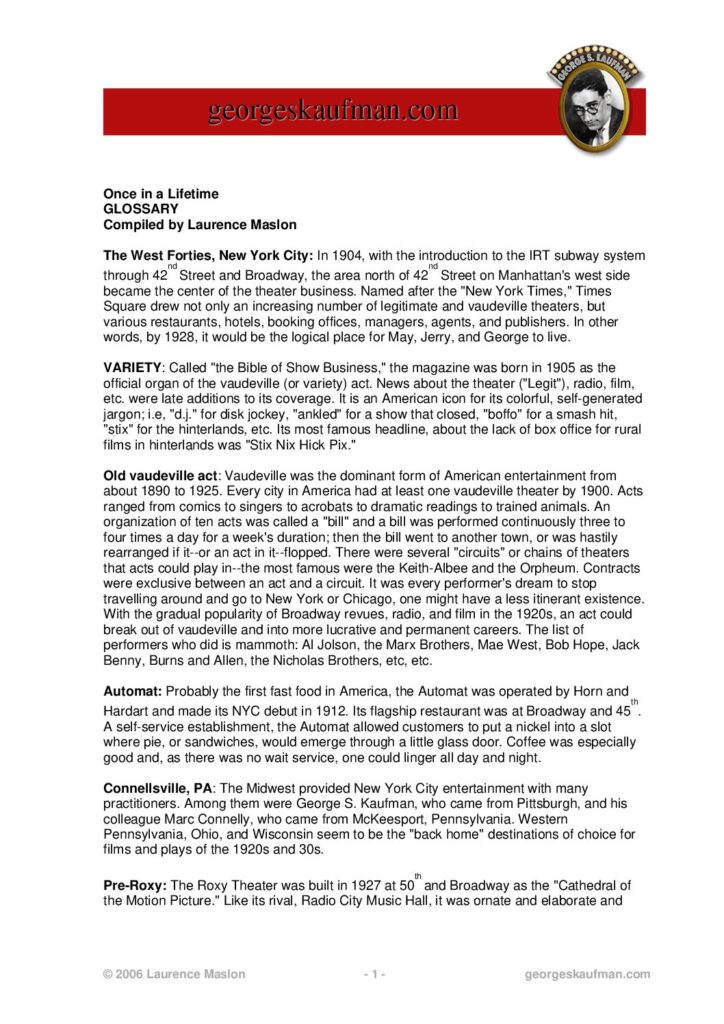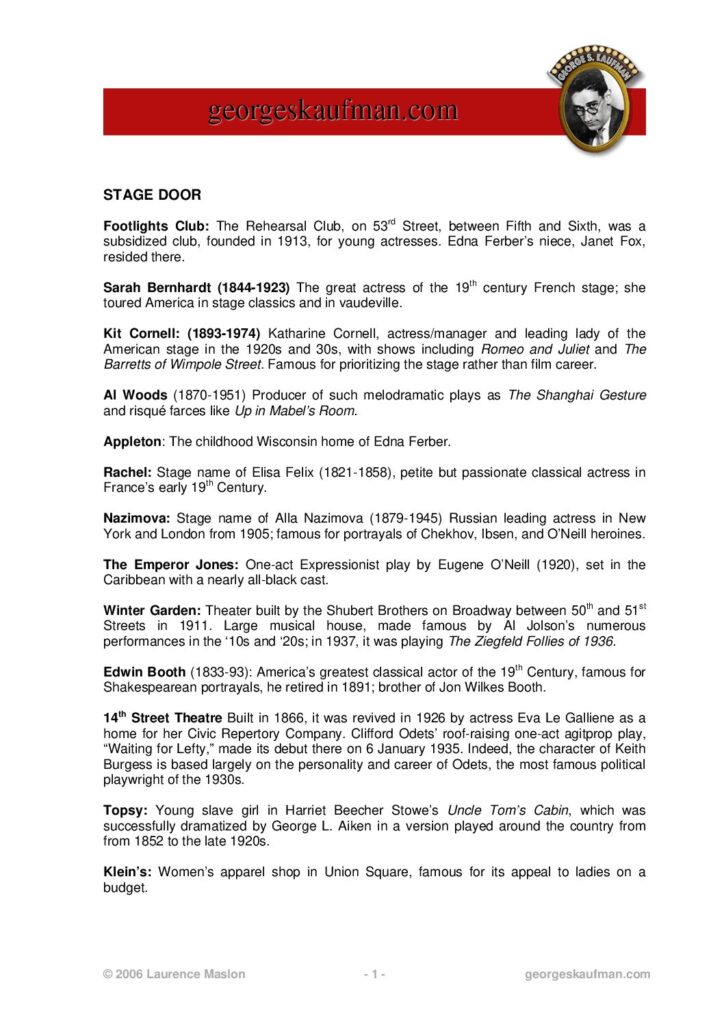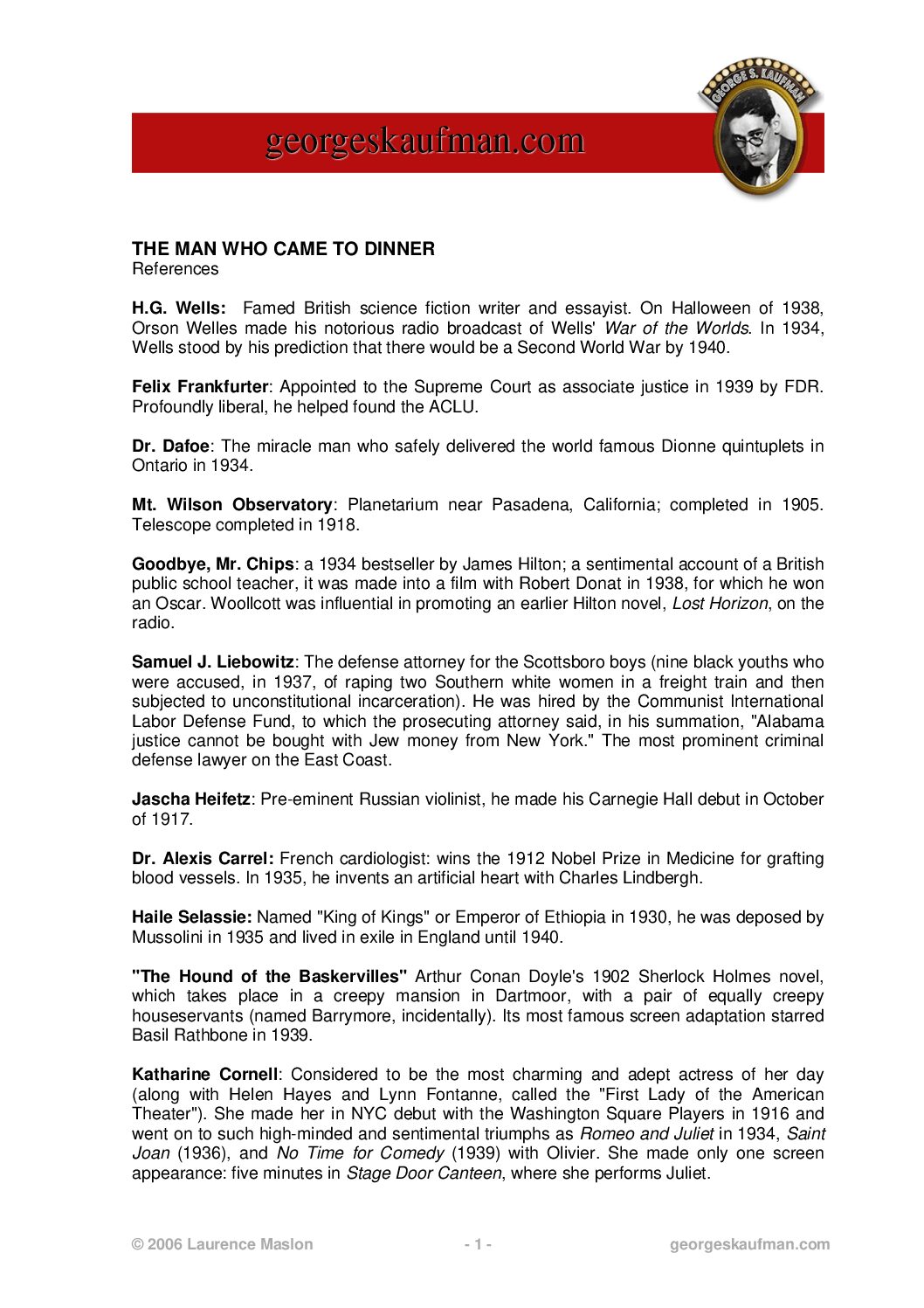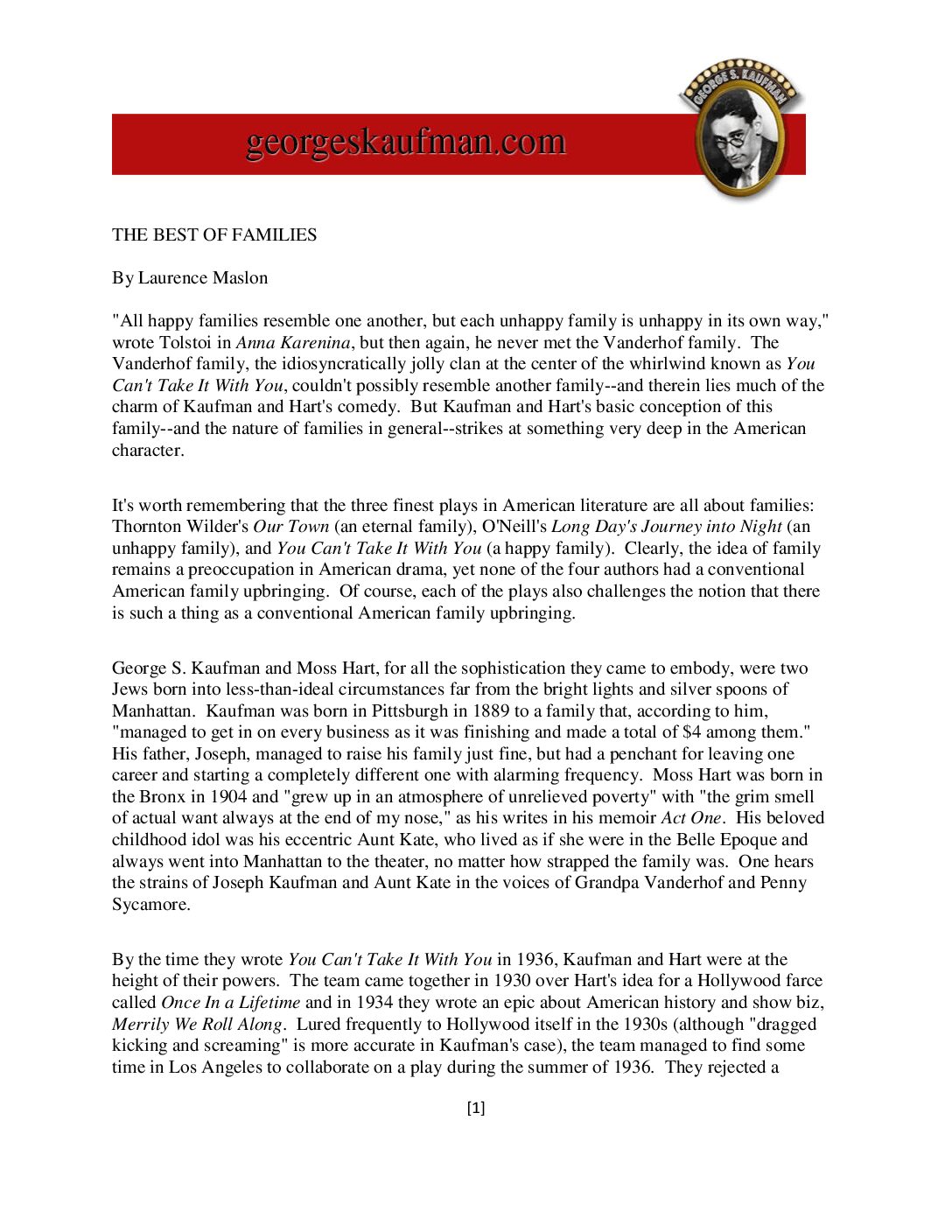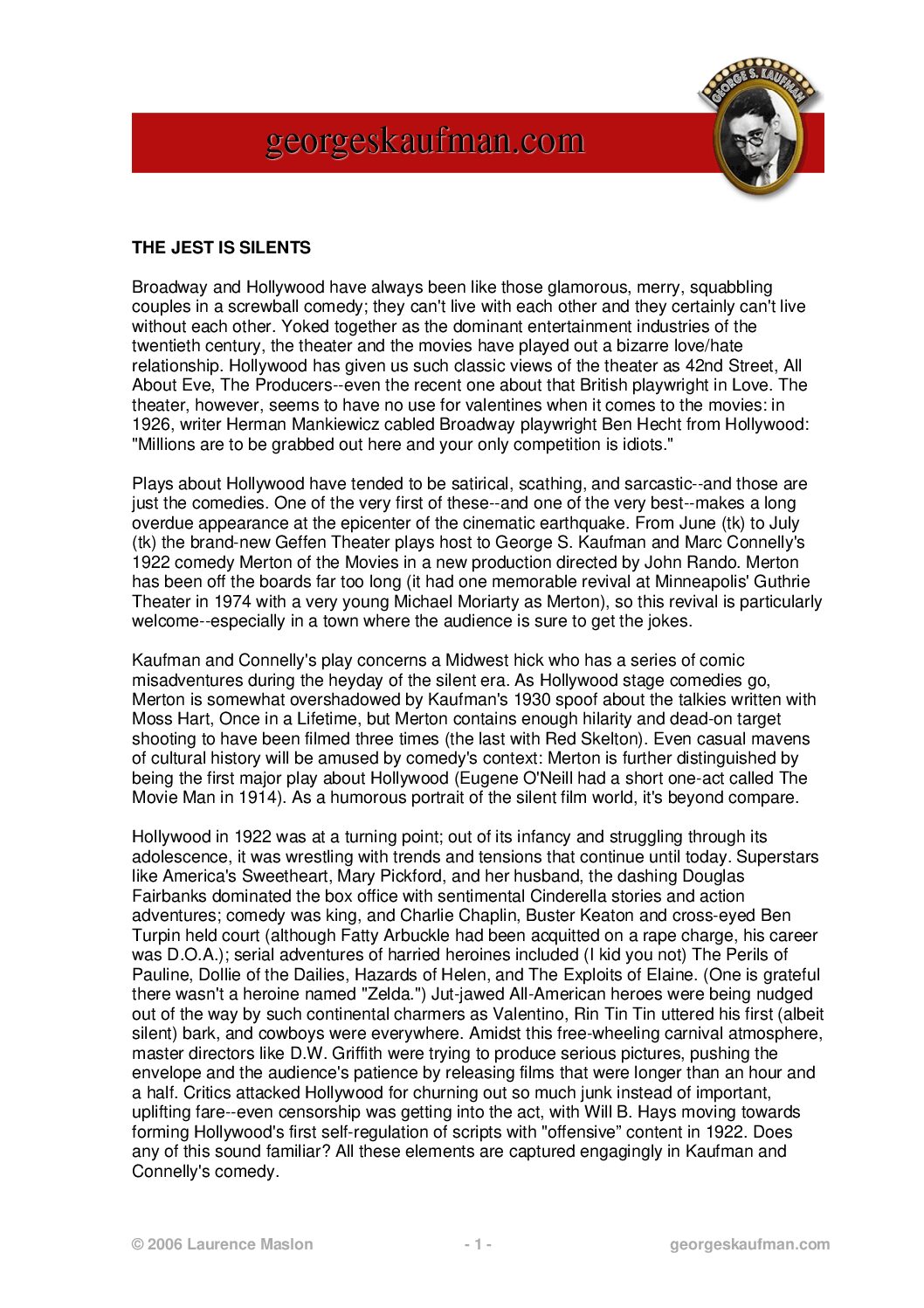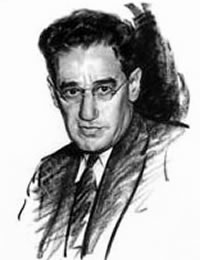Royal Family – Glossary
Royal Family – Glossary
From the George S. Kaufman Archive
Royal Family – Glossary
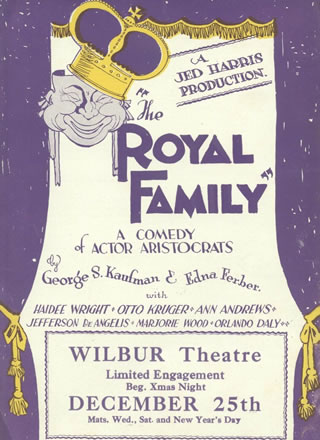 ROYAL FAMILY 1927
ROYAL FAMILY 1927
Stage Magazine New York Times
Act One:
The Garden: Madison Square Garden, had moved to Eighth Avenue and 50th Street in 1925. Saturday night prizefights were particularly popular.
Delaney: Jack Delaney (1900-1956). Canadian boxer, Lighweight champion of the world from December of 1925 to February of 1927.
Lambs Club: a club especially for actors; in 1927, its address was 44th Street b/t 7th and 6th Avenues. Founded by five theatrical types in 1874, members produced four annual “frolics” or Lambscapades. Members are called the Flock and the clubhouse the Fold. George M. Cohan was a particularly enthusiastic member.
Richard Mansfield: (1854-1907) Mansfield was the most forceful and impressive actor at the turn-of-the-century. Renowned, perhaps, for his producing abilities more than his raw talent, he nonetheless undertook such showy roles as Dr. Jekyll and Mr. Hyde, Richard III, Peer Gynt, and Cyrano de Bergerac. He played in New York for part of a season and then toured his repertory, running his company out of his private railway car.
Mannering: Mary Mannering was a British-born actress after the turn-of-the-century. Her last production, in 1911, was The Garden of Allah.
“The Garden of Allah”: produced by impresario George Tyler at the New Theater in 1910, this was a melodramatic romance set in Algeria. It had a big success the previous season in London and was revived in 1920. Its “sand storm” was a major moment.
Piping Rock: a country club near Locust Valley, Long Island. Known for its riding, it was, sadly, the site of Cole Porter’s accident in 1937; his horse tripped and rolled over on him, which cost him the use of his legs.
Minerva: a Belgian-made luxury car, considered to be in the same class as a Rolls-Royce.
Holy Week (Easter week, when shows are traditionally cancelled)
“Mrs. Castlemaine” A fictional play, but Fanny may be referring to vehicles like The Second Mrs,Tanqueray, The Unwelcome Mrs. Hatch, or Lady Frederick–vehicles for Duse, Mrs. Fiske, and Ethel Barrymore, respectively
Follies girl: referring to the Ziegfeld Follies, the major extravagant attraction in New York. Annual editions appeared from 1907 to 1928. Fanny is making fun of how Ziegfeld (who could never tour his shows) thought of himself as the be-all and end-all of urban culture. This would have nothing to do with acting serious plays and reaching real audiences. (New York vs. the Road)
Teacup Theatre: a figure of speech–there was no such theater, but Fanny may be making fun of such “jewel box” 599-seat theaters built between 1909 and 1927 like the Princess, the Bijou, or the Ritz.
Pullmans: durable and roomy travelling train cars, in use from the Civil War to the 1920s. They included kitchen cars, dining cars, and sleepers.
“You can’t call talking pictures acting”: Again, part of the ongoing sentiment, as late as 1927, that film acting–because it was silent–was not a real art form. Also, editing and the fact that, until the mid-1930s, most films were no more than an hour long, mitigated against them being taken seriously by stage actors.
the Astor: the great hotel in the theater district, on Broadway between 44th and 43rd.
Henri Bendel: an impressive ladies’ department store on Fifth Avenue and 57th Street. Julie may be getting her hair or her nails done there.
Camille: an extraordinarly popular play by Alexandre Dumas, fils. Written in 1852, its French title is La Dame aux Camelias, and later became La Traviata. Most major actresses would have played the tubercular heroine, Marguerite in the second half of the 19th Century.
The Two Orphans: a French melodrama from the 1850s: the story of two twins, separated at birth, who grow up in vastly different lives during the French Revolution.
Zeta Zaydak: a fictional name. Foreign films stars were brought to Hollywood in the wake of Valentino’s great success in 1920; Kaufman and Ferber are probably spoofing the Polish/German actresses Pola Negri and Vilma Banky.
The Century: the Twentieth Century; a 16-hour luxury train that ran from Chicago to Grand Central Station. Immortalized in the Hecht/MacArthur play/movie Twentieth Century.
Mauretania. The R.M.S. Mauretania was one of three massive transatlantic liners launched in the 1900s for Cunard: the other two being the Lusitania (torpedoed during WWI) and the Aquitania. It made its maiden voyage in 1907 and was legendary for its speed and on-time arrivals. It was scrapped in 1935.
St. John Throckmorton: a fictional character, but clearly based on Irish critic/playwright St. John Ervine and urbane British writers like Frederick Lonsdale or Somerset Maugham, who were major celebrities in an age before America had “famous” playwrights, like O’Neill or Maxwell Anderson.
Sir Henry Beerbohm Tree (1853-1917): actor/manager, perhaps the most important and flamboyant actor of the British stage at the turn-of-the-century. Renowned for his elaborate spectacle productions of Shakespeare, he was an equally extravagant actor and producer. He built and ran His Majesty’s Theater, and also played contemporary parts like Henry Higgins in the first production of Pygmalion.
“The Gay Lord Quex”: an 1899 play by Sir Arthur Wing Pinero, an elegant and major playwright who brought the “well-made” drawing room play successfully to Britain.
Otto Kahn: (1867-1934) Major financier and socialite. Particularly well-known for his support of the arts, including the Metropolitan Opera House, the New Theater, and the Provincetown Players. (The character of “Chandler” in Animal Crackers is based on Otto Kahn.)
Mineola: A suburb of NYC, on the North Shore of Long Island; also, the Nassau County seat.
Aquitania: Another great transatlantic steamer; maiden voyage in 1913, it held over 2,600 passengers and was in use until 1950.
David Wark Griffith: the greatest American silent film director, influential in terms of scope and storytelling. By 1927, he was no longer at his height, so Kitty’s comment about meeting him (as well as referring to him by his full name), must mean the encounter happened rather long ago.
New Haven: Clearly for the Yale football game
Lackaye: (Wilton Lackaye, who made his Broadway debut in 1887 and performed in Trilby and Trelawney of the “Wells”, among many other shows.
Henry Irving (1838-1905): English actor-manager who dominated the London stage for the last thirty years of Queen Victoria’s reign.
Wallack’s Theatre: Built in 1861, at Union Square, for twenty years this theater dispensed impeccably cast English plays with a company of English actors to an elitist New York audience. By 1915, it was torn down.
“Ah! The immortal passsedo!’ Line of Mercutio’s from Romeo and Juliet (Act II, Sc. 4)– referring to Tybalt, his nemesis
Gascony: a Southern region of France; many swashbucklers seem to hail from there, including D’Artagnan and Cyrano de Bergerac.
“Prince, call upon the Lord!’: Lines from the Act One duel in Cyrano (although not from the Brian Hooker translation which debuted in New York with Richanrd Mansfield in 1898).
Liniment: a kind of early Ben-Gay, for muscle aches and the like
Fauntleroy: “Little Lord Fauntleroy” was the young lad at the center of Frances Hogsdon Burnett’s 1868 novel, where an American boy is revealed to be the heir to an English title. His effete mien, with curly locks and shorts pants, lingered in the public consciousness as the result of a Mary Pickford film version, rather than the book.
Ascher Oszkar Hungarian violin virtuoso
Krishnamurti: (1895-1986) An Indian philosopher and mystic discovered as a child and brought to England, where he was thought to be the next Buddha. He founded the Order of the Star of the East, until he renounced all dogma in 1922, proclaiming that all spiritual authority should be rejected and that the individual was the only person who had control over his spiritual existence.
Isotta Fraschini: an Italian road car and racing car; famous for its four-wheel brakes and the speed records set by Maserati and Ferrari, who drove editions in the 1910s.
Hispano Suiza: Designed in Switzerland and built in Spain, these were the top-of-the-line convertible sports cars; in use until about 1932.
Pink lights: a traditional trick of putting pink gels in the footlights to make actors look younger.
Boise City: capital of Idaho; became a major touring town in mining days in the 1870s.
Diplomacy: an historical epic by Sardou (1843), set in the time of Louis XVI. In a 1928 (all- star) revival, Baron Stein was played by Tyrone Power Senior.
Sandy Hook: cove on New Jersey coast that all liners have to pass by when leaving New York harbor
Elsie Dinsmore: exceedingly virtuous little girl in 36 books by American author Martha Finley.
Theatre Royal: most regional localities outside of London had a major theater named after the royal family; ie, Bath, Brighton, Manchester, etc.
She Stoops to Conquer: Oliver Goldsmith’s sentimental comedy of 1773 was revived frequently by actors (Tony Lumpkin) and actresses (Kate Hardcastle) in the late 19th Century.
A Scrap of Paper: a play by Victorien Sardou (1860); typical of the well-constructed by lifeless “well-made” play pioneered in France by Eugene Scribe.
Macauley’s
Eight o’clock! In the days when most theatergoers lived in Manhattan itself–as opposed to being commuters from the suburbs–the curtain went up at 8:30. This trend continued into the 1950s, when habits changed. “Eight o’clock” would have been “half hour.”
The rabbit’s foot A lucky charm, but also a tool to blend make-up or apply the last coat of powder.
Theater Magazine: Begun in 1900, this was a monthly magazine devoted to stage stars, whose photos frequently adorned the covers. The emerging interest in movie stars put the periodical out of business in 1931.
Bowling Green: One of the earliest sites in Manhattan (the Dutch bowled there), it is closest to New York Harbor, and, hence, the phone exchange for many offices (like the Port Authority).
Keep out of Russia: Only ten years out of Revolution, Russia, with its infighting between the Menshiviks and Bolsheviks, was still a tinderbox in 1927.
A radio: Short for a “radiogram”–a message wired from ship to shore.
Vaudeville: Theatrical stars could make a great deal of money in vaudeville. It was not considered the come-down that it implies. Sarah Bernhardt did dramatic readings in vaudeville and Ethel Barrymore herself made a fortune performing a short play called “The Twelve-Pound Look” about a housewife who leaves her husband when she finds she can make a living as a stenographer. Actors like the Deans could be headliners, although, of course, they would be forced to share the bill with singers, dancers, and comedians
Sir Charles Wyndham (1837-1919). At one point, a surgeon in the Confederate Army, Wyndham has a career both as a touring actor in America, and an actor manager in London, founded the Wyndham’s Theatre.
Theatre of the Future: A general application for ongoing trends in the mid-1920s. After the founding of the New Theater in 1919, many theatre groups were looking to produce indigenous playwrights in America that spoke to the modern public. O’Neill’s Expressionist plays, as well as his relationship with the Provincetown Players in the early 1920s, are axiomatic of what we would now call the “avant garde.”
Gunther: An imaginary character. Curiously, in such other plays as The Man Who Came to Dinner and Moss Hart’s Light Up the Sky, there seems to be a University professor in the middle of nowhere who has written the “Next Great Play.” The reality of theatrical history has proven this to be largely a romantic myth on behalf of Kaufman and Company.
Hungarian play: Gwen is clearly referring to the work of Ferenc Molnar, (1878-1952), a major Hungarian playwright of the early 20th Century. The Theatre Guild made huge successes of his work, including The Guardsman and Liliom, which became the basis for Carousel.
Theatre Guild: Undeniably the most important and presitigious producing organization on Broadway in the 1920s and 1930s. Founded in 1919, it produced literary plays with starry casts with a subscription policy. It had its ups-and-downs–and its fans and detractors–but its record is unique and impressive. Among the plays its produced were Strange Interlude, Biography, They Knew What They Wanted, The Adding Machine and, in the 1940s, The Philadelphia Story and Oklahoma!
Shaw: Many of Shaw’s plays had their world premieres at the Theatre Guild: Heartbreak House, Saint Joan and Caesar and Cleopatra.
New York brand: This was during Prohibition, after all. Perhaps Gil prefers the quality alcoholic beverage from South America over the New York contraband made in bathtubs or imported from Canada.
Reinhardt: Max Reinhardt (1873-1943) Austrian director and producer. Easily the most ambitious European director of his day, his productions were on a vast scale: using Catherdrals, or open spaces, tents, etc. He also was a pioneer in using new technology; ie, projections, automations, etc. for his productions.
Pitoeff: Georges Pitoeff (1887-1939). A Russian émigré who came to Paris after the First World War and was influential in bringing new playwrights and staging techniques to the star-heavy Paris theatre. He was particularly successful in encouraging and directing imaginative productions of Shaw, Shakespeare, and Pirandello.
Constructivist scenery: Not so far-fetched. The Bauhaus Theatre Lab, under the guidance of director Edwin Piscator, had worked out several schemes for a revolving audience in the early 1920s. Scenography and theatrical architecture in general were undergoing huge revolutions in Europe in the 1920s: Reinhardt, Meyerhold, Piscator, Robert Edmond Jones, etc.
Passion Play: One of the earliest forms of European drama, this cycle was based on the cycle of Christ’s death. Performed around Easter, it gradually only became a living tradition in Catholic countries by the 19th Century. The Oberammergau Passion Play in Bavaria continues to this day. It may be that Kaufman and Ferber are also spoofing Reinhardt’s massive production of Jedermann, or “Everyman,” which became a major event at the Salzburg Cathedral in 1920.
 ROYAL FAMILY 1927
ROYAL FAMILY 1927
Stage Magazine New York Times
Act One:
The Garden: Madison Square Garden, had moved to Eighth Avenue and 50th Street in 1925. Saturday night prizefights were particularly popular.
Delaney: Jack Delaney (1900-1956). Canadian boxer, Lighweight champion of the world from December of 1925 to February of 1927.
Lambs Club: a club especially for actors; in 1927, its address was 44th Street b/t 7th and 6th Avenues. Founded by five theatrical types in 1874, members produced four annual “frolics” or Lambscapades. Members are called the Flock and the clubhouse the Fold. George M. Cohan was a particularly enthusiastic member.
Richard Mansfield: (1854-1907) Mansfield was the most forceful and impressive actor at the turn-of-the-century. Renowned, perhaps, for his producing abilities more than his raw talent, he nonetheless undertook such showy roles as Dr. Jekyll and Mr. Hyde, Richard III, Peer Gynt, and Cyrano de Bergerac. He played in New York for part of a season and then toured his repertory, running his company out of his private railway car.
Mannering: Mary Mannering was a British-born actress after the turn-of-the-century. Her last production, in 1911, was The Garden of Allah.
“The Garden of Allah”: produced by impresario George Tyler at the New Theater in 1910, this was a melodramatic romance set in Algeria. It had a big success the previous season in London and was revived in 1920. Its “sand storm” was a major moment.
Piping Rock: a country club near Locust Valley, Long Island. Known for its riding, it was, sadly, the site of Cole Porter’s accident in 1937; his horse tripped and rolled over on him, which cost him the use of his legs.
Minerva: a Belgian-made luxury car, considered to be in the same class as a Rolls-Royce.
Holy Week (Easter week, when shows are traditionally cancelled)
“Mrs. Castlemaine” A fictional play, but Fanny may be referring to vehicles like The Second Mrs,Tanqueray, The Unwelcome Mrs. Hatch, or Lady Frederick–vehicles for Duse, Mrs. Fiske, and Ethel Barrymore, respectively
Follies girl: referring to the Ziegfeld Follies, the major extravagant attraction in New York. Annual editions appeared from 1907 to 1928. Fanny is making fun of how Ziegfeld (who could never tour his shows) thought of himself as the be-all and end-all of urban culture. This would have nothing to do with acting serious plays and reaching real audiences. (New York vs. the Road)
Teacup Theatre: a figure of speech–there was no such theater, but Fanny may be making fun of such “jewel box” 599-seat theaters built between 1909 and 1927 like the Princess, the Bijou, or the Ritz.
Pullmans: durable and roomy travelling train cars, in use from the Civil War to the 1920s. They included kitchen cars, dining cars, and sleepers.
“You can’t call talking pictures acting”: Again, part of the ongoing sentiment, as late as 1927, that film acting–because it was silent–was not a real art form. Also, editing and the fact that, until the mid-1930s, most films were no more than an hour long, mitigated against them being taken seriously by stage actors.
the Astor: the great hotel in the theater district, on Broadway between 44th and 43rd.
Henri Bendel: an impressive ladies’ department store on Fifth Avenue and 57th Street. Julie may be getting her hair or her nails done there.
Camille: an extraordinarly popular play by Alexandre Dumas, fils. Written in 1852, its French title is La Dame aux Camelias, and later became La Traviata. Most major actresses would have played the tubercular heroine, Marguerite in the second half of the 19th Century.
The Two Orphans: a French melodrama from the 1850s: the story of two twins, separated at birth, who grow up in vastly different lives during the French Revolution.
Zeta Zaydak: a fictional name. Foreign films stars were brought to Hollywood in the wake of Valentino’s great success in 1920; Kaufman and Ferber are probably spoofing the Polish/German actresses Pola Negri and Vilma Banky.
The Century: the Twentieth Century; a 16-hour luxury train that ran from Chicago to Grand Central Station. Immortalized in the Hecht/MacArthur play/movie Twentieth Century.
Mauretania. The R.M.S. Mauretania was one of three massive transatlantic liners launched in the 1900s for Cunard: the other two being the Lusitania (torpedoed during WWI) and the Aquitania. It made its maiden voyage in 1907 and was legendary for its speed and on-time arrivals. It was scrapped in 1935.
St. John Throckmorton: a fictional character, but clearly based on Irish critic/playwright St. John Ervine and urbane British writers like Frederick Lonsdale or Somerset Maugham, who were major celebrities in an age before America had “famous” playwrights, like O’Neill or Maxwell Anderson.
Sir Henry Beerbohm Tree (1853-1917): actor/manager, perhaps the most important and flamboyant actor of the British stage at the turn-of-the-century. Renowned for his elaborate spectacle productions of Shakespeare, he was an equally extravagant actor and producer. He built and ran His Majesty’s Theater, and also played contemporary parts like Henry Higgins in the first production of Pygmalion.
“The Gay Lord Quex”: an 1899 play by Sir Arthur Wing Pinero, an elegant and major playwright who brought the “well-made” drawing room play successfully to Britain.
Otto Kahn: (1867-1934) Major financier and socialite. Particularly well-known for his support of the arts, including the Metropolitan Opera House, the New Theater, and the Provincetown Players. (The character of “Chandler” in Animal Crackers is based on Otto Kahn.)
Mineola: A suburb of NYC, on the North Shore of Long Island; also, the Nassau County seat.
Aquitania: Another great transatlantic steamer; maiden voyage in 1913, it held over 2,600 passengers and was in use until 1950.
David Wark Griffith: the greatest American silent film director, influential in terms of scope and storytelling. By 1927, he was no longer at his height, so Kitty’s comment about meeting him (as well as referring to him by his full name), must mean the encounter happened rather long ago.
New Haven: Clearly for the Yale football game
Lackaye: (Wilton Lackaye, who made his Broadway debut in 1887 and performed in Trilby and Trelawney of the “Wells”, among many other shows.
Henry Irving (1838-1905): English actor-manager who dominated the London stage for the last thirty years of Queen Victoria’s reign.
Wallack’s Theatre: Built in 1861, at Union Square, for twenty years this theater dispensed impeccably cast English plays with a company of English actors to an elitist New York audience. By 1915, it was torn down.
“Ah! The immortal passsedo!’ Line of Mercutio’s from Romeo and Juliet (Act II, Sc. 4)– referring to Tybalt, his nemesis
Gascony: a Southern region of France; many swashbucklers seem to hail from there, including D’Artagnan and Cyrano de Bergerac.
“Prince, call upon the Lord!’: Lines from the Act One duel in Cyrano (although not from the Brian Hooker translation which debuted in New York with Richanrd Mansfield in 1898).
Liniment: a kind of early Ben-Gay, for muscle aches and the like
Fauntleroy: “Little Lord Fauntleroy” was the young lad at the center of Frances Hogsdon Burnett’s 1868 novel, where an American boy is revealed to be the heir to an English title. His effete mien, with curly locks and shorts pants, lingered in the public consciousness as the result of a Mary Pickford film version, rather than the book.
Ascher Oszkar Hungarian violin virtuoso
Krishnamurti: (1895-1986) An Indian philosopher and mystic discovered as a child and brought to England, where he was thought to be the next Buddha. He founded the Order of the Star of the East, until he renounced all dogma in 1922, proclaiming that all spiritual authority should be rejected and that the individual was the only person who had control over his spiritual existence.
Isotta Fraschini: an Italian road car and racing car; famous for its four-wheel brakes and the speed records set by Maserati and Ferrari, who drove editions in the 1910s.
Hispano Suiza: Designed in Switzerland and built in Spain, these were the top-of-the-line convertible sports cars; in use until about 1932.
Pink lights: a traditional trick of putting pink gels in the footlights to make actors look younger.
Boise City: capital of Idaho; became a major touring town in mining days in the 1870s.
Diplomacy: an historical epic by Sardou (1843), set in the time of Louis XVI. In a 1928 (all- star) revival, Baron Stein was played by Tyrone Power Senior.
Sandy Hook: cove on New Jersey coast that all liners have to pass by when leaving New York harbor
Elsie Dinsmore: exceedingly virtuous little girl in 36 books by American author Martha Finley.
Theatre Royal: most regional localities outside of London had a major theater named after the royal family; ie, Bath, Brighton, Manchester, etc.
She Stoops to Conquer: Oliver Goldsmith’s sentimental comedy of 1773 was revived frequently by actors (Tony Lumpkin) and actresses (Kate Hardcastle) in the late 19th Century.
A Scrap of Paper: a play by Victorien Sardou (1860); typical of the well-constructed by lifeless “well-made” play pioneered in France by Eugene Scribe.
Macauley’s
Eight o’clock! In the days when most theatergoers lived in Manhattan itself–as opposed to being commuters from the suburbs–the curtain went up at 8:30. This trend continued into the 1950s, when habits changed. “Eight o’clock” would have been “half hour.”
The rabbit’s foot A lucky charm, but also a tool to blend make-up or apply the last coat of powder.
Theater Magazine: Begun in 1900, this was a monthly magazine devoted to stage stars, whose photos frequently adorned the covers. The emerging interest in movie stars put the periodical out of business in 1931.
Bowling Green: One of the earliest sites in Manhattan (the Dutch bowled there), it is closest to New York Harbor, and, hence, the phone exchange for many offices (like the Port Authority).
Keep out of Russia: Only ten years out of Revolution, Russia, with its infighting between the Menshiviks and Bolsheviks, was still a tinderbox in 1927.
A radio: Short for a “radiogram”–a message wired from ship to shore.
Vaudeville: Theatrical stars could make a great deal of money in vaudeville. It was not considered the come-down that it implies. Sarah Bernhardt did dramatic readings in vaudeville and Ethel Barrymore herself made a fortune performing a short play called “The Twelve-Pound Look” about a housewife who leaves her husband when she finds she can make a living as a stenographer. Actors like the Deans could be headliners, although, of course, they would be forced to share the bill with singers, dancers, and comedians
Sir Charles Wyndham (1837-1919). At one point, a surgeon in the Confederate Army, Wyndham has a career both as a touring actor in America, and an actor manager in London, founded the Wyndham’s Theatre.
Theatre of the Future: A general application for ongoing trends in the mid-1920s. After the founding of the New Theater in 1919, many theatre groups were looking to produce indigenous playwrights in America that spoke to the modern public. O’Neill’s Expressionist plays, as well as his relationship with the Provincetown Players in the early 1920s, are axiomatic of what we would now call the “avant garde.”
Gunther: An imaginary character. Curiously, in such other plays as The Man Who Came to Dinner and Moss Hart’s Light Up the Sky, there seems to be a University professor in the middle of nowhere who has written the “Next Great Play.” The reality of theatrical history has proven this to be largely a romantic myth on behalf of Kaufman and Company.
Hungarian play: Gwen is clearly referring to the work of Ferenc Molnar, (1878-1952), a major Hungarian playwright of the early 20th Century. The Theatre Guild made huge successes of his work, including The Guardsman and Liliom, which became the basis for Carousel.
Theatre Guild: Undeniably the most important and presitigious producing organization on Broadway in the 1920s and 1930s. Founded in 1919, it produced literary plays with starry casts with a subscription policy. It had its ups-and-downs–and its fans and detractors–but its record is unique and impressive. Among the plays its produced were Strange Interlude, Biography, They Knew What They Wanted, The Adding Machine and, in the 1940s, The Philadelphia Story and Oklahoma!
Shaw: Many of Shaw’s plays had their world premieres at the Theatre Guild: Heartbreak House, Saint Joan and Caesar and Cleopatra.
New York brand: This was during Prohibition, after all. Perhaps Gil prefers the quality alcoholic beverage from South America over the New York contraband made in bathtubs or imported from Canada.
Reinhardt: Max Reinhardt (1873-1943) Austrian director and producer. Easily the most ambitious European director of his day, his productions were on a vast scale: using Catherdrals, or open spaces, tents, etc. He also was a pioneer in using new technology; ie, projections, automations, etc. for his productions.
Pitoeff: Georges Pitoeff (1887-1939). A Russian émigré who came to Paris after the First World War and was influential in bringing new playwrights and staging techniques to the star-heavy Paris theatre. He was particularly successful in encouraging and directing imaginative productions of Shaw, Shakespeare, and Pirandello.
Constructivist scenery: Not so far-fetched. The Bauhaus Theatre Lab, under the guidance of director Edwin Piscator, had worked out several schemes for a revolving audience in the early 1920s. Scenography and theatrical architecture in general were undergoing huge revolutions in Europe in the 1920s: Reinhardt, Meyerhold, Piscator, Robert Edmond Jones, etc.
Passion Play: One of the earliest forms of European drama, this cycle was based on the cycle of Christ’s death. Performed around Easter, it gradually only became a living tradition in Catholic countries by the 19th Century. The Oberammergau Passion Play in Bavaria continues to this day. It may be that Kaufman and Ferber are also spoofing Reinhardt’s massive production of Jedermann, or “Everyman,” which became a major event at the Salzburg Cathedral in 1920.
More from the
George S. Kaufman Archive
Contact Us Today
Interested in bringing George S. Kaufman’s timeless plays to your stage?
Please refer to the contact information for each specific play on the various collection pages for direct amateur and professional licensing information.
Plays are represented by Concord Theatricals, Broadway Dramatic Licensing, and Music Theatre International respectively
If you are interested in first-class performance or film/television rights:
In the US, George S. Kaufman’s plays are represented by:
CPK Artists, LLC
In the UK, George S. Kaufman’s plays are represented by:
Alan Brodie Representation
For more information about George S. Kaufman or this website, contact:
Laurence Maslon
Literary Trustee, George S. Kaufman Estate

